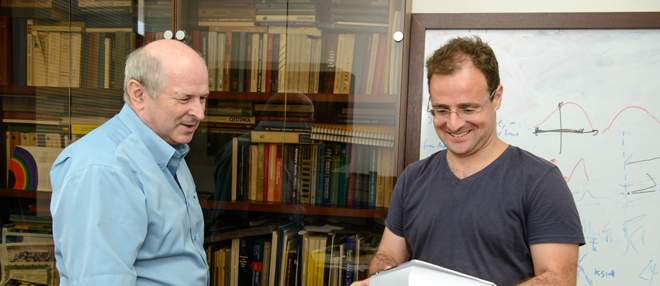Are you a journalist? Please sign up here for our press releases
Subscribe to our monthly newsletter:
A ball kicked at the goal, a molecule in a gas, a galaxy in space: each of these is moving with two kinds of velocity. The linear velocity of the body moves it from place to place while its angular velocity causes it to spin. Several years ago, a proposal was put forward in which short pulses of laser light aimed at molecules in a gas would affect the rotation of these molecules. These flashes of laser light – a few trillionths of a second long, about the time it takes a small molecule to complete one spin on its axis – would accelerate the molecules’ rotation, creating a sort of “optical centrifuge.”

Prof. Ilya Averbukh of the Weizmann Institute’s Chemical Physics Department asks: “What happens when an optical centrifuge is aimed at a bunch of molecules that are moving around naturally in the air? The laser pulse will polarize the molecules – aligning their rotational axes with the direction of the light beam. And the laser pulse will cause their rotational speed to be quite a bit faster than the linear speed that is carrying them through space.” The spinning molecules now act like tiny gyroscopes, or “superrotors,” and the angular distribution of the molecules flattens out like a pancake in a plane perpendicular to the light beam.
Averbukh and his colleagues – Drs. Yuri Khodorkovsky and Uri Steinitz of the Institute, and Prof. Jean-Michel Hartmann from France – wanted to understand the behavior of a gas of molecular superrotors – a unique gaseous state that has rarely been studied. They created a computer simulation involving nitrogen or oxygen molecules that get hit with a short laser pulse. The idea was to understand how energy is transferred within such a system between angular and linear motion as the molecules collide with one another randomly.
The basic laws of thermodynamics teach us that superrotors cannot keep up their extraordinary rate of spinning indefinitely, as the system must eventually reach thermal equilibrium. In the case of the spinning molecules, this means that the angular motion must slow down as it transfers energy to other types of motion.
The basic laws of thermodynamics teach us that superrotors cannot keep up their extraordinary rate of spinning indefinitely
The simulation revealed that even though the superrotors collide randomly with surrounding molecules, the gyroscope-like movements are maintained for quite a long time, surviving despite numerous molecular collisions. In fact, according to the simulation, collisions between superrotors barely affect their angular velocity, so the superrotor population in the gas is maintained at close to its original level. This is an unusual state in nature – a metastable gas of aligned “pancakes.”
Nonetheless the system does go toward equilibrium, and the energy of rotations gradually leaks over to translational motion. As energy moves around, the gas slowly heats up and thus the rate of collisions increases. More frequent collisions lead to an acceleration of the energy transfer, and eventually the system blows up, as a rapid “chain reaction” ends in an explosive heating of the gas. The scientists think that the "snowball" of rapid heating is initiated by rare collisions between a few relatively slowly spinning molecules and others that are moving at a high linear speed.
Immediately after this theoretical work was published, the predicted crossover from one state to another in a gas of superrotor molecules was observed experimentally by one of the leading laser groups in Canada. Related acoustic, hydrodynamic and optical effects in a gas of superrotors may find numerous applications in science and technology, including controlled wave guiding and remote atmosphere sensing.
Animated visualization of the explosive collisional relaxation in a gas of oxygen super-rotors. Each particle is represented by a spindle whose axis corresponds to the rotation axis, and its length depicts the rotation speed. The color of each particle codes the translational speed
Prof. Ilya Aerbukh is the incumbent of the Patricia Elman Bildner Professorial Chair of Solid State Chemistry.